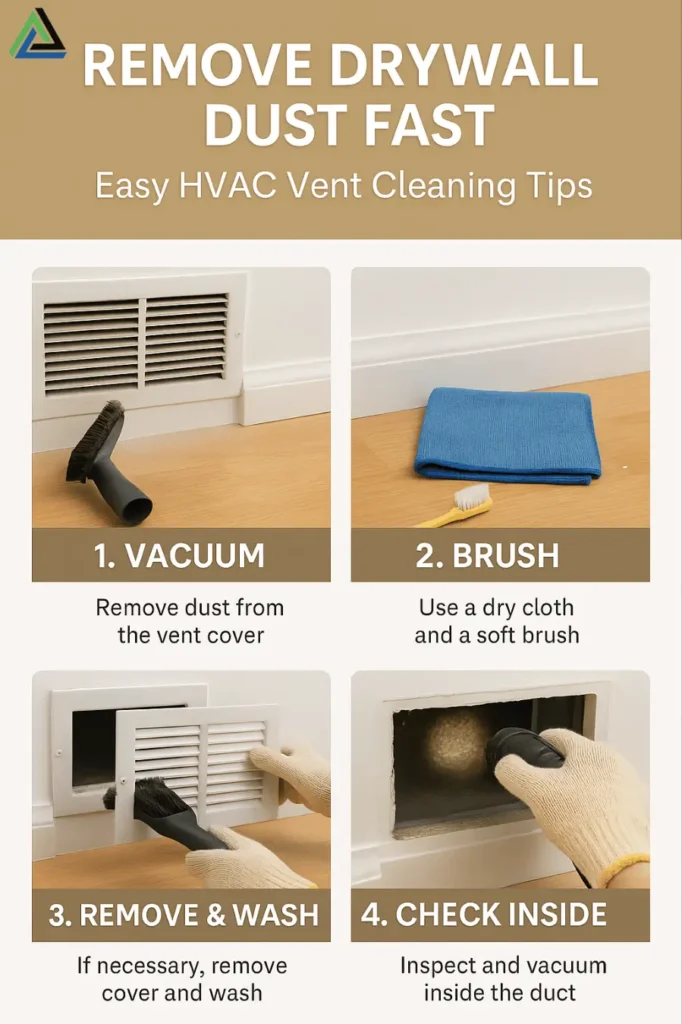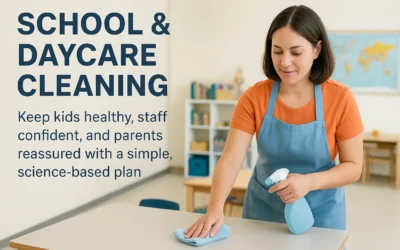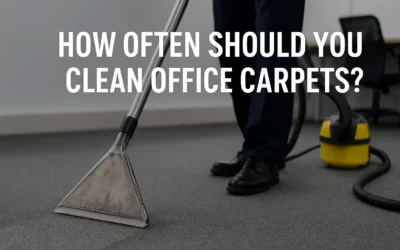How to Remove Drywall Dust from Air Vents Without Specialized Tools
Picture this: sunlight slants across your brand-new living room, revealing a ghostly plume rising from each floor register. You cough, your dog sneezes, and your HVAC hums ominously. Ever wonder if that fine chalky haze is quietly sandblasting your lungs and furnace fan? Here’s the kicker… You can purge that drywall dust today—no costly duct vacuum, no professional crew, just household odds and ends and a dash of know-how.
The Renovation Aftermath: Why Vents Get Clogged
Drywall sanding produces particles under 10 microns—so light they hang in the air for hours. Those motes ride convection currents straight into open supply and return vents, where they pile up like gray talcum. But wait… isn’t ordinary lint already in there? True, yet silica-rich drywall dust is sharper; it scours blower wheels and irritates sinuses. The U.S. EPA warns that built-up debris can reduce airflow and foster mold if left damp.
Fine Dust vs. Everyday Lint
Typical household lint clumps and stays visible; drywall dust, by contrast, feels powder-soft, squeaks under your fingertips, and floats at the faintest draft. That ghostly quality lets it slip through coarse return filters and settle far down the duct run—right where a broom can’t reach.
Health & HVAC Risks
Inhaling drywall dust may trigger coughing fits and worsen asthma. OSHA rules even bar dry sweeping in workplaces where silica is present because airborne clouds spike exposure OSHA. Translation: kick up less dust, breathe easier, and save your blower motor from an early retirement.
Safety First, Gear Second
You don’t need a hazmat suit, but you do need to stay safe.
- Mask Up: A snug N95 from your paint drawer blocks 95 % of particles.
- Eye Protection: Clear goggles keep grit from scratching corneas.
- Gloves: Cotton knit gloves improve grip when prying vent covers.
Flip the thermostat off at the breaker. That kills suction, preventing fresh dust clouds the moment you lift the register. Bonus: it saves energy while you work.
The No-Tool Toolkit
- Painter’s Tape & Plastic Sheeting: Cover adjacent furniture and seal nearby returns.
- Vacuum Brush Attachment: Every home vacuum ships with one. It’s not specialized—just under-used.
- Microfiber Cloth & Old Toothbrush: Soft fibers snag the finest powder; stiff bristles wiggle between slats.
Everything here probably sits in your closet right now. Um… see? No shopping trip needed.
Step-by-Step Quick Clean: How to Remove Drywall Dust from Air Vents Without Specialized Tools

1 — Pop Off the Vent Covers
Grab a flathead screwdriver, angle it under the frame, and lift gently. Set screws in a jar—dog-shiny floors make tiny hardware disappear. Rhetorical question: how many lost screws lurk under your sofa already?
2 — Loosen Dust, Don’t Launch It
Drape the vent cover in a plastic tub. Stroke each slat with your old toothbrush while your vacuum’s hose hovers 2 cm away. This “brush-and-capture” motion mimics the EPA’s recommended well-controlled brushing without the $1,000 duct whip.
3 — Capture, Contain, Dispose
Line a bucket with a trash bag. Knock residual dust into it, cinch tight, and move on. Every sealed bag means fewer particles resuspended when you empty the vacuum canister later.
Deep-Clean Tricks for Tight Budgets
DIY Baking-Soda Wash
Fill a basin with warm water, two tablespoons of dish soap, and one tablespoon of baking soda. Swish vent covers for ten minutes. This mild alkali breaks gypsum residue without corroding paint, echoing advice from seasoned duct techs online.
Damp Mop-Handle “Reach-In” Method
Wrap a microfiber cloth around a damp (not dripping) mop handle. Twist into the first 60 cm of ductwork, rolling the cloth like a lint trap. Replace cloths as they gray out. A homeowner-tested trick, it sidesteps pricey extendable brushes.
Protecting Indoor Air Quality After Cleanup
Swap your furnace filter immediately; drywall dust overloads cheap pleated filters in hours. Some pros suggest changing twice weekly post-renovation. While the HVAC is still off, vacuum the filter slot, slide in a fresh MERV-8 or higher, then power up.
For extra peace of mind, run the system on Fan Only for ten minutes, then recheck filter color. Pale gray? You’re clear. Charcoal? Repeat the quick clean.
Long-Tail Fixes for Pets, Babies & Allergies
Pet hair magnetizes dust. Lay adhesive vent filters for two weeks to trap stray grit.
New-baby nursery? Position a portable HEPA purifier beside the supply vent until that room’s register swipes come out clean.
Apartment dwellers often can’t open main ducts. Focus on removable covers, keep windows cracked, and ask management to inspect building exhaust fans.
Transactional Angle: When to Call a Pro
If you see caked mud beyond arm’s length, smell a musty waft, or spot rodent droppings, professional duct cleaning makes sense. Yet remember: the EPA says duct cleaning isn’t routinely necessary—only when confirmed buildup exists US EPA.
Preventive Moves Before Your Next Remodel
- Seal & Cover Vents: ContractorPlus suggests taping supply and return vents before sanding begins
- Pick Low-Dust Joint Compound: Bagged “dust-control” mud forms heavier particles that fall, not float.
- Wet-Sand Whenever Feasible: Spritz walls lightly; the sludge drops straight to a tarp.
Preventing dust beats chasing it—every time.
FAQs
Q1. Can I just vacuum inside the duct?
Yes, but insert the nozzle only as far as you can see. Over-reaching may dislodge duct tape seams.
Q2. Is compressed air safe for blasting dust out?
Not at home. OSHA forbids dry blasting in dusty job sites because it aerosolizes silica OSHA.
Q3. What if my vent covers are wood?
Skip soaking; wipe with a barely damp microfiber, then dry fast to avoid warping.
Q4. How often should I repeat this cleaning?
Once right after sanding, again after final paint, then revert to your normal seasonal schedule.
Q5. Do adhesive vent filters restrict airflow?
Slightly. Use them as a short-term guard, not a permanent solution.
Q6. Will an air purifier replace vent cleaning?
No. Purifiers catch airborne dust after it leaves the duct; cleaning removes the source





